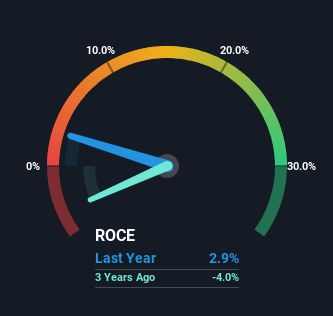- United Kingdom
- /
- Specialty Stores
- /
- AIM:ANG
The Returns On Capital At Angling Direct (LON:ANG) Don't Inspire Confidence
To find a multi-bagger stock, what are the underlying trends we should look for in a business? Firstly, we'd want to identify a growing return on capital employed (ROCE) and then alongside that, an ever-increasing base of capital employed. This shows us that it's a compounding machine, able to continually reinvest its earnings back into the business and generate higher returns. Having said that, from a first glance at Angling Direct (LON:ANG) we aren't jumping out of our chairs at how returns are trending, but let's have a deeper look.
Understanding Return On Capital Employed (ROCE)
For those that aren't sure what ROCE is, it measures the amount of pre-tax profits a company can generate from the capital employed in its business. To calculate this metric for Angling Direct, this is the formula:
Return on Capital Employed = Earnings Before Interest and Tax (EBIT) ÷ (Total Assets - Current Liabilities)
0.029 = UK£1.4m ÷ (UK£64m - UK£14m) (Based on the trailing twelve months to July 2023).
Thus, Angling Direct has an ROCE of 2.9%. In absolute terms, that's a low return and it also under-performs the Specialty Retail industry average of 14%.
View our latest analysis for Angling Direct

In the above chart we have measured Angling Direct's prior ROCE against its prior performance, but the future is arguably more important. If you'd like to see what analysts are forecasting going forward, you should check out our free report for Angling Direct.
What The Trend Of ROCE Can Tell Us
When we looked at the ROCE trend at Angling Direct, we didn't gain much confidence. Around five years ago the returns on capital were 7.8%, but since then they've fallen to 2.9%. Meanwhile, the business is utilizing more capital but this hasn't moved the needle much in terms of sales in the past 12 months, so this could reflect longer term investments. It may take some time before the company starts to see any change in earnings from these investments.
On a side note, Angling Direct has done well to pay down its current liabilities to 22% of total assets. So we could link some of this to the decrease in ROCE. Effectively this means their suppliers or short-term creditors are funding less of the business, which reduces some elements of risk. Some would claim this reduces the business' efficiency at generating ROCE since it is now funding more of the operations with its own money.
The Key Takeaway
To conclude, we've found that Angling Direct is reinvesting in the business, but returns have been falling. And investors appear hesitant that the trends will pick up because the stock has fallen 54% in the last five years. Therefore based on the analysis done in this article, we don't think Angling Direct has the makings of a multi-bagger.
One more thing to note, we've identified 1 warning sign with Angling Direct and understanding it should be part of your investment process.
If you want to search for solid companies with great earnings, check out this free list of companies with good balance sheets and impressive returns on equity.
New: Manage All Your Stock Portfolios in One Place
We've created the ultimate portfolio companion for stock investors, and it's free.
• Connect an unlimited number of Portfolios and see your total in one currency
• Be alerted to new Warning Signs or Risks via email or mobile
• Track the Fair Value of your stocks
Have feedback on this article? Concerned about the content? Get in touch with us directly. Alternatively, email editorial-team (at) simplywallst.com.
This article by Simply Wall St is general in nature. We provide commentary based on historical data and analyst forecasts only using an unbiased methodology and our articles are not intended to be financial advice. It does not constitute a recommendation to buy or sell any stock, and does not take account of your objectives, or your financial situation. We aim to bring you long-term focused analysis driven by fundamental data. Note that our analysis may not factor in the latest price-sensitive company announcements or qualitative material. Simply Wall St has no position in any stocks mentioned.
About AIM:ANG
Angling Direct
Engages in the sale of fishing tackle products and equipment in the United Kingdom, Europe, and internationally.
Flawless balance sheet with proven track record.
Market Insights
Community Narratives



